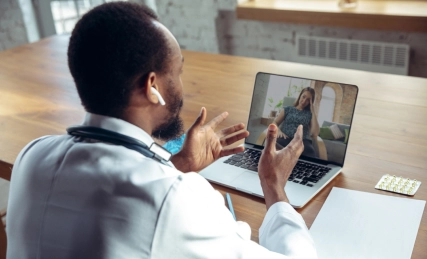- Platform
- About us
- Resources
- Events
WhiteSpace Health Blogs

10 Tips to Create a Digital First Patient Experience
by Chris Cousins, MBA

The wave of the future is already here. Patients are looking for their healthcare to be digital first. Now that most patients have high deductible health plans and 28% of provider revenue comes from patients, consumerism is beginning to gain critical mass and influence change. And patients have the power, more than ever, to vote with their wallets, says Chris Cousins.Chris, a 30 year veteran of health care in C suite roles,who has spent his career focusing on the revenue cycle and operations across many large recognizable health care brands.
Chris firmly believes that providers and all manner of healthcare organizations will need to embrace this change to thrive.

During a recent guest appearance on our "The RCM Experts" podcast, Cousins said that patients are looking for convenience that extends from finding the right provider all the way to closing out their financial responsibility. When selecting a healthcare provider, patients are demanding high quality care as well as convenience that includes availability of telehealth and a good experience.“All too often, revenue cycle gets pigeonholed as a back-office function rather than a fully integrated process that begins with scheduling all
the way through to satisfaction of patient responsibility,” says Cousins.Traditionally, we have considered pre-visit, clinical time, and post-visit to be the patient account lifecycle. But it is so much more. We now realize that it begins the moment the patient opens a browser and begins to seek care and continues until the account is closed with a zero balance. From the medical practice and care provider perspective, RCM should not be separate from the CBO or Central Business Office. “We need to look at the patient experience and the revenue cycle holistically rather than segmenting out parts of the whole experience.”

Here are 10 ways to give patients a better experience and help your RCM process before patients even set foot through your door.
Gather pre-visit data and verify at check-in.
This sets the stage for how smoothly the revenue cycle will proceed. This information should also be used to completely re-imagine the pre-visit process.
Use geofencing to up the game on service.
The use of GPS technology creates a virtual geographic boundary around your clinic. This enables software to let you know when patients are close by. With this little bit of advance warning on a patient's arrival, your concierge team be ready to welcome them.
Re-imagine and eliminate the waiting room.
“The term “waiting room” sets the expectation that patients are going to wait. It’s a horrible first impression. The pandemic played its part in reimagining this aspect of care, by advancing technologies, establishing the digital front door and how patients access and experience healthcare in a mobile-first way. Replacing old fashioned waiting rooms with a greeter or concierge like experience, similar to an Apple store, makes the onsite patient flow smoothly.
Use patient demographics and insurance information to improve claim accuracy and management of the revenue cycle.
Gathering this information in advance of the appointment to verify insurance coverage and eligibility, when apt, is key to a smooth revenue cycle and predictable collections.
Reduce friction associated with patient visits.

Make it as easy as possible for both your staff and the patients. Historically, front desk staff were used to greet patients and perform data entry simultaneously. Because they were constantly being interrupted to welcome patients for their appointments, a lot of errors were created, giving the revenue cycle a rocky start. By getting data collected before the appointment, a quick verification is all that will be needed when the patient arrives. By performing this data quality check, the claims generally go much smoother, and payment is expedited.
Offer telehealth as a convenience.

The pandemic made virtual care acceptable, and now patients are demanding it. Telehealth is not generation specific. Rather, it appears to be more geographically based. Busy people really appreciate telehealth. By analyzing the types of care that can be rendered via telehealth, such as follow up appointments, all members of the care team can be used effectively and the patient can access care anywhere from a mobile device.
Ensure clinicians work at the top of their licenses.

Use care extenders for lower acuity cases like UTIs, prescription refills, etc. Physician time should be reserved for more complex cases that require longer appointment times. By scheduling follow up visits with mid-levels, your provider utilization will likely increase long with your billings.
Reset perceived wait time for patients.
Technology has re-shaped our brains on how we experience time. In the past, a 15-minute wait used to feel like 5 minutes to a patient. Now the reverse is true. Patients expect instant gratification. They are becoming increasingly frustrated over wait times – when actually wait times are going down. From a psychology standpoint, there are ways to reset this. One of these ways is to offer patients water. These sorts of interventions break the time cycles in our brains and reset perceived time.
Work with payers to stop automatic batch denials.
To lower friction and the cost of doing business with us, consider working with key payers to identify a subset of claim types that are automatically being denied. If the provider can provide consistent, high-quality care alongside the correct documentation, the payer partners can confidently authorize payment. By creating trust among trading partners,automatically denied claims are reduced, and friction for all stakeholders, lowering cost and leading to zero balance accounts faster.
Use technology to streamline the revenue cycle and the onsite patient experience.
Other ways healthcare organizations can give patients a better experience using all of technologies and digital shortcuts, include:
- Real-time eligibility discovery and verification,
- Out-of-pocket estimators to determine a patient's financial responsibility,
- Mobile payment capabilities, replacing paper statements
- Specialty-specific forms to ensure the patient fills out only what is relevant,
- Pushing messages from providers to inform patients and re-setting expectations,
- QR codes that patients scan to complete the check-in process when they enter.
About Chris Cousins
